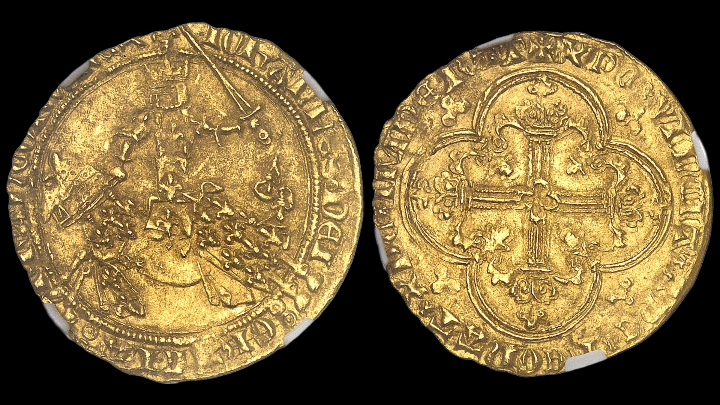Among French royal coinage, the franc à cheval of John II the Good, struck around 1360, stands out as one of the most iconic types of the 14th century. A true symbol of monarchical resilience in times of crisis, this gold coin embodies the king's strength in the face of adversity, particularly within the troubled context of the Hundred Years’ War.
With its rich iconography, refined aesthetic, and political significance, the franc à cheval is far more than a collectible object — it is a precious witness to the history of France, and a solid investment for any serious collector.
Avec son iconographie riche, son esthétique, et sa signification politique, le franc à cheval est bien plus qu’un objet de collection : c’est un témoin précieux de l’histoire de France, et une valeur sûre pour tout collectionneur averti.
The Coin: Royal Power and Striking Finesse
This franc à cheval was issued without a date (ND, or non daté), but is identified as struck around 1360, during the reign of John II the Good (1350–1364). Composed of pure gold, it weighs 3.77 g and measures 27 mm in diameter. This particular example is graded MS 64 by NGC, making it the finest known specimen to date (Top Pop) — a decisive feature for elite collectors.
On the obverse, King John II is depicted on horseback, galloping proudly to the left. He raises a sword, symbolizing his military authority. His helmet, crowned with a fleur-de-lis, and his fleur-de-lis-covered surcoat visually emphasize his status as a Most Christian King. The horse’s floral caparison, entirely adorned with fleurs-de-lis, reinforces the sacred imagery of royalty and dynastic continuity.
The legend, written in Latin, reads: IOHANNES: DEI: GRACIA: FRANCORV: REX (“John, by the grace of God, King of the Franks”), highlighting the divine sovereignty of the monarch.
The reverse features a foliate cross, centered within a decorated quadrilobe, with a smaller quadrilobe at its heart. Each quadrant is adorned with a hollow trefoil, completing a highly symbolic medieval composition.
The inscription reads: + XPC VINCIT + XPC REGNAT + XPC IMPERAT (“Christ conquers, Christ reigns, Christ commands”), granting the coin a sense of divine and universal legitimacy.

History: John II the Good – Between Captivity and Reform
This franc à cheval was minted in a dramatic context. In 1356, John II was captured by the English at the Battle of Poitiers, a major turning point in the Hundred Years’ War. His captivity triggered a profound political and financial crisis for the kingdom.
To stabilize the situation, a monetary reform was enacted: the franc à cheval was introduced in 1360, to mark the king’s release in exchange for a ransom. The word “franc”, derived from the Latin francus (meaning free), refers to the king’s liberation, while simultaneously establishing a new unit of account — the franc, which would later become a foundational element of France’s monetary history.
Through this coin, John II sought to reaffirm royal authority and restore confidence in gold currency. Its iconography was carefully designed to send a clear message: the king has returned — legitimate, victorious, and supported by divine right.
A Numismatic Pioneer
The franc à cheval of John II the Good is an exceptional coin, not only for its visual beauty, but also for its deep historical significance. This specimen, graded MS 64 by NGC, stands out for its strike quality and rarity, placing it among the most prestigious pieces in medieval numismatics.
This example was sold for €3,600.
If you are looking for this coin, ask us — and we will find it for you.